
Bellingham is the county seat of Whatcom County in the U.S. state of Washington. It lies 21 miles (34 km) south of the U.S.–Canada border, between Vancouver, British Columbia, 52 miles (84 km) to the northwest and Seattle 90 miles (140 km) to the south.

Whatcom County is a county located in the northwestern corner of the U.S. state of Washington, bordered by the Lower Mainland of British Columbia to the north, Okanogan County to the east, Skagit County to the south, San Juan County across Rosario Strait to the southwest, and the Strait of Georgia to the west. Its county seat and largest population center is the coastal city of Bellingham, comprising the Bellingham, WA Metropolitan Statistical Area, and as of the 2020 census, the county's population was 226,847.

The LummiNation is a federally-recognized tribe of primarily Lummi people. The Lummi Nation also includes some Nooksack, Samish, and other local tribes which were removed to the reservation. It is based in the coastal area of the Pacific Northwest region of Washington state in the United States, and is located within the Bellingham Metropolitan Area

Lake Whatcom is located in Whatcom County, Washington, United States. It is the drinking water source for approximately 85,000 residents in the city of Bellingham as well as Whatcom County. It is approximately 10 miles (16 km) in length and 1 mile (1.6 km) in width at its widest. Lake Whatcom is located and managed within three political jurisdictions: the city of Bellingham, Whatcom County, and the Lake Whatcom Water and Sewer District. The lake is a popular area for motor boating, swimming, fishing, and other recreational activities.

Eastsound is an unincorporated community on Orcas Island in San Juan County, Washington, United States. Eastsound is the largest population center on Orcas Island, the second-most populated and physically largest of the San Juan Islands.
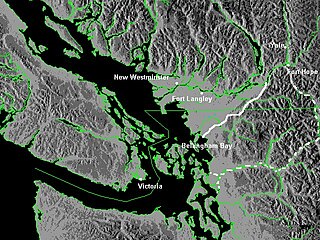
The Whatcom Trail was an overland trail from the Puget Sound area of Washington Territory during the Fraser Canyon Gold Rush of 1858. The trail began on Bellingham Bay, at Fairhaven, the route used went via a route known as the Columbia Valley, which is a lowland route connecting the mid-Nooksack River area with Cultus Lake and the lower Chilliwack River in the Upper Fraser Valley, about 80 km east of today's Vancouver. In 1858, T. G. Richards built the first brick building in Washington as an outfitter for those using the Whatcom Trail.

Eliza Island is located in the western part of Bellingham Bay in the U.S. state of Washington. It lies just east of the southern part of Lummi Island, in Whatcom County. Eliza Island has a land area of 0.571 km2. Its population was ten persons as of the 2010 census.
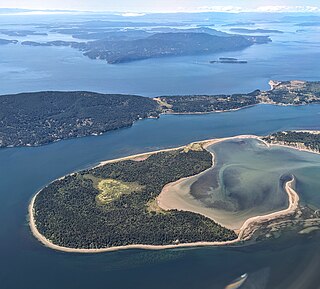
Portage Island is an island in the western part of Bellingham Bay in Whatcom County, Washington, United States. It is separated from the Lummi Peninsula by Portage Bay and from the central part of Lummi Island by Hale Passage, in Whatcom County. Portage Island has a land area of 3.803 km2. There was no resident population as of the 2000 census. According to the Whatcom County Assessors database, the land and the surrounding tide flats are owned by the Lummi Native American tribe. The island is wholly contained within the boundaries of the Lummi Indian Reservation.

Bellingham Bay is a bay of the Salish Sea located in Washington State in the United States. It is separated from the Strait of Georgia on the west by the Lummi Peninsula, Portage Island, and Lummi Island. It is bordered on the east by Bellingham, Washington, to the south-east by the Chuckanut Mountains, and to the south by Samish Bay. The Nooksack River empties into the bay, as does Whatcom Creek.
The Bellingham Waterfront consists of the land along Bellingham Bay in Whatcom County, Washington, United States. It is mostly in Bellingham, Washington and other surrounding neighborhoods and cities. Various Bellingham neighborhoods are along the waterfront including is shared with Fairhaven.

The U.S. state of Washington is home to a number of public and private ferry systems, most notably the state-run Washington State Ferries.
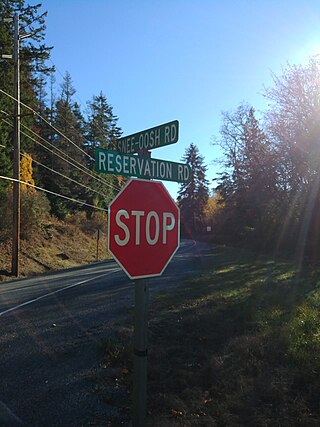
Snee Oosh is a populated place on Fidalgo Island in the U.S. state of Washington, on the Swinomish Indian Reservation. The population was reported as 302 in 1999.
The history of Bellingham, Washington, as it is now known, begins with the settling of Whatcom County in the mid-to-late 19th century.
Hale Passage is the name of two different bodies of water in Puget Sound, in the U.S. state of Washington.

Kulshan was a steamship which operated on Puget Sound from 1910 until 1929. When built, Kulshan was one of a newer type of inland steamships constructed entirely of steel, and was then considered one of the finest vessels ever to operate on Puget Sound.
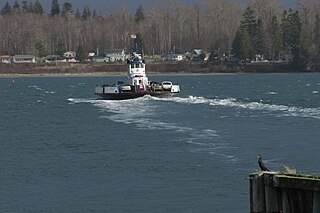
The Whatcom Chief is a ferry in Washington state, United States. The ferry carries both pedestrians and vehicles to Lummi Island from Gooseberry Point west of Bellingham, Washington.

Carlisle II is the oldest of only two operational examples of a Puget Sound Mosquito Fleet vessel. They were once part of a large fleet of small passenger and freight carrying ships that linked the islands and ports of Puget Sound in Washington state in the late 19th and early 20th centuries.
The Gateway Pacific Terminal was a proposed export terminal at Cherry Point in Whatcom County, Washington, along the Salish Sea shoreline. It was announced in 2011 and would have exported coal, but was opposed by local residents and the Lummi Nation, who had an ancestral village site at Cherry Point. The terminal project was rejected by the U.S. Army Corps of Engineers in 2016, ruling that it would infringe on the fishing rights of the Lummi Nation.
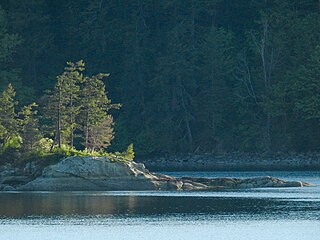
Chuckanut Bay is a crescent-shaped bay about three miles (4.8 km) long in southwestern Whatcom County, directly south of Bellingham, Washington, United States. The bay was formed along the axis of a plunging syncline during the formation of the Chuckanut Mountains. It is situated on the eastern shore of the Salish Sea at the southeast end of Bellingham Bay. The bay was named Puerto del Socorro by Lieutenant Juan Francisco de Eliza in 1791. The present name was chosen by Captain Henry Roeder on December 1, 1852. Natural features include Pleasant Bay located south of Chuckanut Bay, Mud Bay to the north, and Chuckanut Island and Chuckanut Rocks to the west. Other natural features include Teddy Bear Cove, Governors Point and Clark Point. Several creeks drain into the bay, including Chuckanut Creek and Fragrance Lake Outlet. The bay is home to tafoni formations found in the area.

The Interurban Trail is a rail trail in Whatcom County, Washington. Built for bicycle and hiking recreation, the trail runs 6.6 miles (10.6 km) between Fairhaven and Larrabee State Park in the Bellingham area.


















